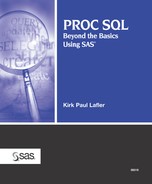2.5. Summary
The available data types in SQL are 1) numeric and 2) character (see section 2.2).
When a table is created with PROC SQL, numeric columns are assigned a default length of 8 bytes (see section 2.2.1).
SAS tables store date and time information in the form of a numeric data type (see section 2.2.2).
A CHAR column stores a default of 8 characters (see section 2.2.3).
Missing or unknown information is supported by PROC SQL in a form known as a null value. A null value is not the same as a zero value (see section 2.2.5).
Comparison operators are used in the SQL procedure to compare one character or numeric value to another (see section 2.3.1).
Logical operators (AND, OR, and NOT) are used to connect one or more expressions together in a WHERE clause (see section 2.3.2).
The arithmetic operators used in the SQL procedure are the same as those used in the DATA step (see section 2.3.3).
Character string operators and functions are typically used with character data (see section 2.3.4).
Predicates are used in the SQL procedure to perform direct comparisons between two conditions or expressions (see section 2.3.6).
Dictionary tables provide information about the SAS environment (see section 2.4).
